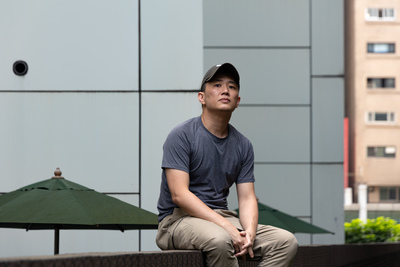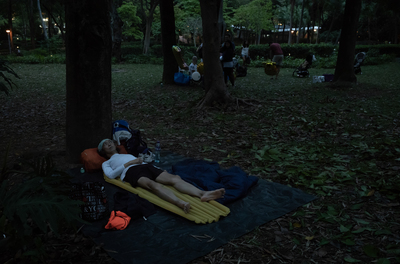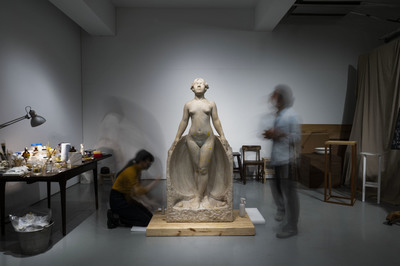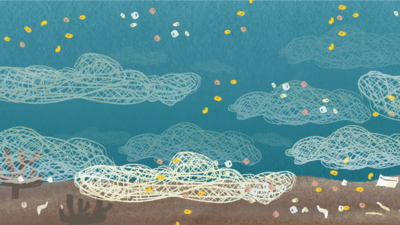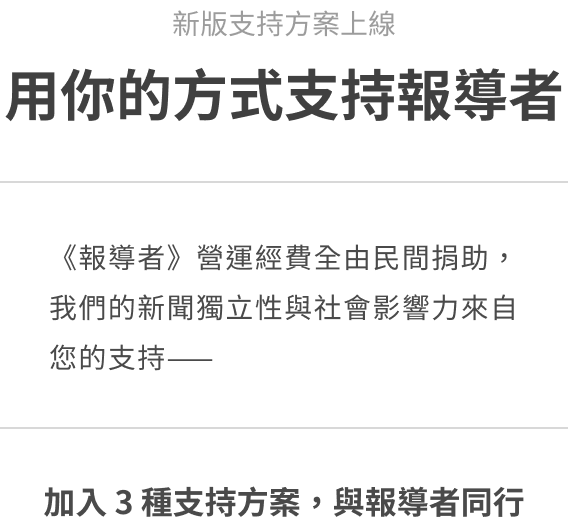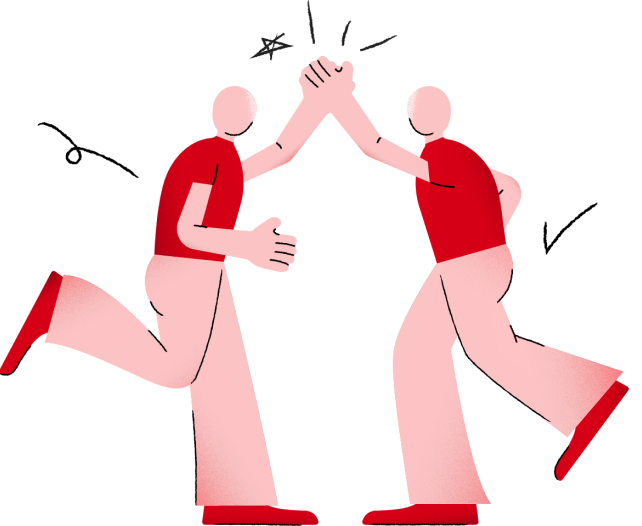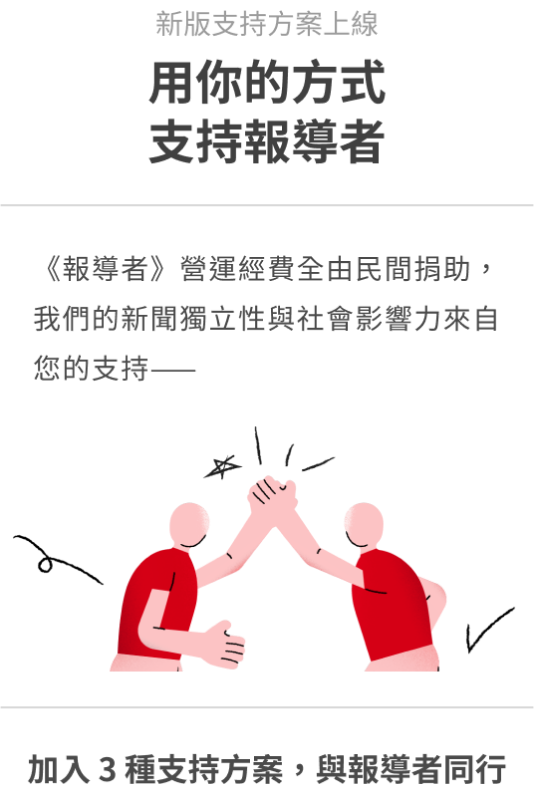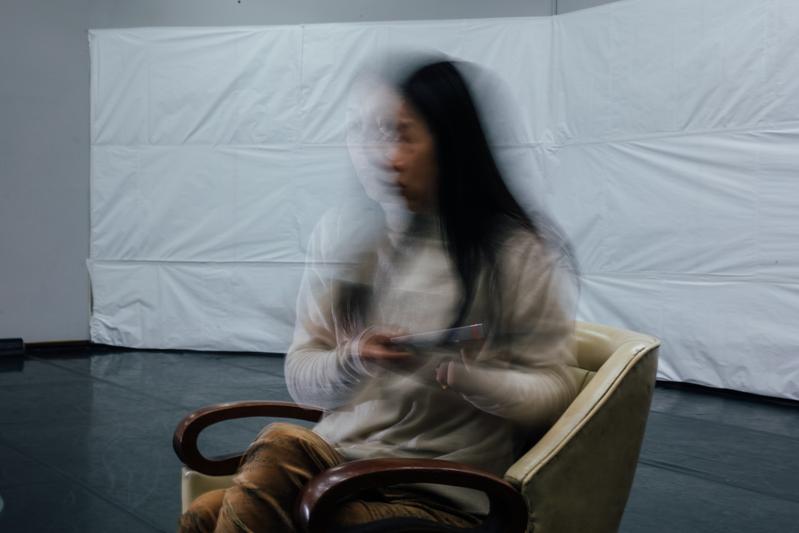
Yao Shu-fen (姚淑芬) studied ballet for 20 years, but quit after just one class. After living a nomadic lifestyle overseas, she decided to become a choreographer. She’s the recipient of Taiwan’s National Award of Art for her work in dance, and also the founder of the Century Contemporary Dance Company.
The interview almost didn’t happen. The timing was never right. She was busy performing her new work “The Age of Silence”, and was moving to a new office space.
But just as we were ready to give up, the phone call came. Yao Shu-fen — the founder and artistic director of the Century Contemporary Dance Company, and recipient of the 2018 National Award of Art — had time for an interview.
Not even spoken a few sentences, Yao made her own conclusion about her role in Taiwan’s dance scene — she was an outlier. Her outgoing demeanour, refreshing laughter, and extroverted nature makes her vastly different from more reserved artists. In turn, those around her unconsciously throw away their reservations, laugh with her and relax.
As for her work, the dance world might also consider her an outlier. She was once asked quizzically in an interview, “Is what you do even considered dance?” But her work is never just dance.
In 2006, the Newcastle Arts Festival commissioned Yao’s piece “I Get a Kick Out of You.” It was the first work to combine soccer and dance.
To commemorate the 10th anniversary of its founding in 2010, the Century Contemporary Dance Company put on “Les Noces / Le Sacre Du Printemps,” a piece that combines elements of Western and Eastern culture, with the music of Igor Stravinsky, and the paintings of Wang Pan-Youn (王攀元) — a fellow recipient of the National Award of Art). It received the 9th Taishin Arts Award for Performing Arts.
In 2013, Taiwan’s National Theater and Concert Hall commissioned her to create “Wings of Desire,” a piece that incorporated elements of the Wim Wenders film of the same name. During the performance, a live video of the dance floor was projected on the backdrop, exhibiting two types of movement, and enriching the visual layers and meaning of the work.
Yao Shu-Fen is a choreographer who oversteps boundaries, and breaks the rules without fear.
During the interview, I asked Yao about the “interdisciplinary” or “cross-cutting” nature of her work. It was unfortunate that I did so, because these terms are wasted on her. For Yao, “interdisciplinary” is not deliberate, but something that happens organically. She is not making a dance, she is making a work of art, and dance is only a part of it.
Yao Shu-Fen never wanted to be an artist closed in by the theatre, rather one that has drowned themselves in pure creation. “Art is not only inviting people to enter the theatre; art should also walk amongst the crowd,” she said.
Beginning in 2007, Yao worked with shops in the Yongkang Shopping District to hold “Welcome: Flashmob to Yongkang Street, Taipei.” The event took the form of a community art festival, where audience members would follow the footsteps of the performers as they weaved through Yongkang street, and learned more about the shop owners through artistic performances. It also provided young artistic creators a platform to express themselves.
In 2014, she pushed for exchange among Taiwan’s neighbours, inviting young choreographers from Japan, Hong Kong and Korea to take part in the “Driving the City” project.
“Yao Shu-fen loves travel, loves making friends” said theatre reviewer Lin Nai-Wen (林乃文) in his book ‘Cross-World Theatre, People.’ “She’s not the silent introverted type, or the type of artist who steals away into her own inner world. She is more like a passionate communicator… the way she speaks has the grandeur of the proprietress of the Dragon Inn. People from all over can sit, converse, laugh and be touched by her presence.”
Yao was born in 1964. As a child, she was always full of energy, and unable to sit calmly. At the age of five, her mother decided to send her to dance classes. During her first class, she cried from beginning to end, and wanted to go home, but with time, she learned to like it.
At 15, she was accepted into the Department of Dance at the National Academy of Arts (now the National Taiwan University of Arts). She looked forward to the day she could fulfill her parents wishes and rely on her dance skills to make a living.
But Yao always felt inferior to her peers. She is naturally flat-footed, and had to work harder than others. To improve her instep, she would put her feet in the crack in the piano base to stretch out her feet. With inflexible legs and waist, she was not able to perform advanced movements, and could only keep stretching. She would abuse her body in so many ways, forcing her body to create soft and beautiful movements. At the time, she believed as long as she kept going, she had a place in the ballet world.
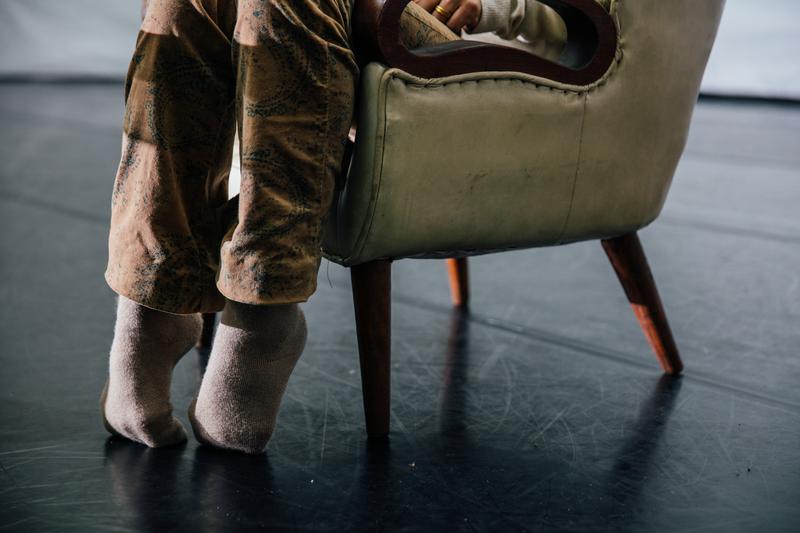
Tired after dancing eight hours of classical ballet, she would go to the club at night to relax. “I’m a nightclub girl,” she says with a laugh. “I could follow my heart and create my own dance steps at the club. Every time I started dancing, everyone would automatically move away, giving me the whole floor to dance.”
At the age of 25, Yao arrived in New York, her heart filled with joy. But after just one ballet class, she decided to give it all up, a craft she had painstakingly learned for 20 years.
The ballet curriculum she took part in was developed by David Howard, a renowned ballet dancer and teacher, and included professional dancers from well-known ballet companies. Yao realized she would never reach their standards, from the beauty of the movement to their body structures. “The difference was miles apart,” said Yao. In Taiwan, she thought if she trained hard, she had some hope, but after leaving Taiwan, she truly understood her body wasn’t suitable for ballet.
Even modern dance class, which she loved, would give her the strong feeling that there were always people more talented than her. She began to doubt herself. “It doesn’t matter if it’s ‘Cats’ or ‘The Chorus Line’, or any other Broadway musical, every dancer was more nimble, wearing high slit skirts and three inch heels. How was I supposed to compete with them?”
But if she didn’t have the natural body type of a dancer, how would she support herself in the future? “I found out that I really liked to create. Even if I was fortunate to become a dancer, I wouldn’t be able to dance my whole life. But there are no limits to creation, and it can last a lifetime.”
Luckily, Yao Shu-fen received a scholarship from the Merce Cunningham Dance Company, and entered the Dance department at New York University, where she majored in performance and choreography.
Studying in a foreign country also came with hardship. At the time, a single course costed $600 USD, and she had to complete 72 courses; the tuition alone was well over $43,000 USD. She begged the bank to allow her to apply for a student loan. She worked in coat check at clubs, earning a dollar per coat. Without money for rent, she couch-surfed, or exchanged dog walking for a bed.
Roaming and moving around the city had left an indelible mark. “I’m not able to live in one place for long. I have to keep moving to allow my soul to calm down,” said Yao. “Living a nomadic lifestyle in NYC was even the inspiration for “Dream Hatched’” — a piece that featured mattresses scattered around the stage, representing a place where an ordinary person can find respite in this chaotic world.
After returning to Taiwan, she had difficulty paying back her student loans. What’s more, to present her works to the Taiwanese public, she needed to look for even more loans. Her parents were confused. The family had five siblings, and only she had pursued dance. They had put all their hopes in her. They were prepared to wait for a return on their investment after she returned with a master’s degree, but not only was there nothing, she even had to borrow more money.
Yao thought about giving up choreographing altogether. One year, she made up her mind and traveled all over Taiwan to teach. She endured for eleven months, but she could not help but return to choreographing. “Without the ability to create, I would not be able to live,” she said.
Years later, Yao finally understands her burning desire to create “was because [I] needed an exit.” Everything she had seen in her life, all her setbacks and pain, needed to be expressed through choreography. “The reason for constant creation is there. Because things keep happening, there’s never ending source material,” she said.
People in Taiwan’s dance circle say that Yao Shu-fen is a “choreographer that uses her pores to breathe,” and any trifle in life can become a work of art.
At the beginning of our interview, everyone in her office was busy chasing away flies. Yao waved her hand and said, “Later I will choreograph a buzzing dance… I’m serious. I’m not joking!” At the time, everyone started laughing, but there is likely a glimmer of truth to her promise.
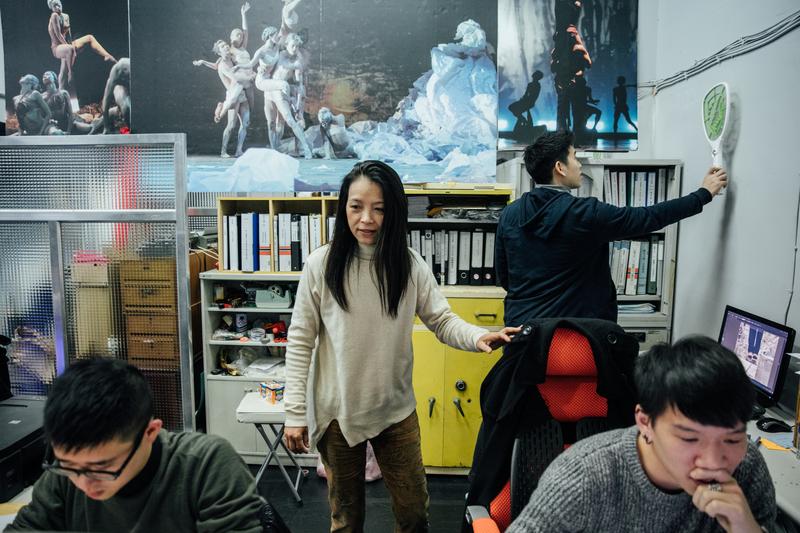
She never worries about a lack of inspiration when choreographing, she only worries about it coming too late. She had a serious creative block when choreographing “Double Happiness” in 2002. At the first rehearsal, she entered the practice room, and immediately saw a rubber band holding up a dancer’s hair.
“Take off the band in your hair,” she said. “What do you want to do?”
Yao Shu-Fen did not say a thing. She tied the rubber band on her hand, and improvised four eight counts of the main dance sequence. The rubber band later became a red silk string in the performance, representing the string that binds two people who seal their fate in marriage.
But her creative streak ended there, and she made no progress after that. Her face showed distress when she entered the rehearsal room, as if a black cloud hovered over her. No one dared to ask what happened. No one uttered a word, and everyone continued to practice the same four eight counts.
Until one day, when she entered the office of National Taiwan University of Arts and saw a box of sweet preserves on her desk. It was a gift from a student, from a famous store in Tainan. Without saying a thing, she brought the box to the rehearsal room. She said to the dancer portraying the groom: “Please eat some preserves.” She then started explaining the later movements.
Then she asked the dancer portraying the bride to walk from stage left to stage right, then walk from stage right to front stage left.
“Is this a joke?” “It’s not a joke. Just walk.” “I don’t need to dance?” “No need to dance, just walk.”
The dancers had no idea what Yao was doing, but in her heart, she had already choreographed the entire dance. It was that box of preserves that opened a childhood memory in Tainan. She liked to watch glove puppetry shows growing up in Tainan. That’s where her inspiration came from. Glove puppetry symbolized the words of a matchmaker, similar to the puppets being controlled, unable to be autonomous. On stage, the bride was lead by the red string, walking back and forth, seeking her soulmate.
“It is really surprising. A lot of people ask me where my creativity comes from. I say don’t ask me, because I don’t even know. It’s all from life, but you never know when it will jump out.”
When choreographing “Dream Hatched” in 2001, most of the dance was complete, but Yao felt something was missing. She didn’t know “what the dance was trying to express?”
At the time, the dance company rehearsal space was in an old building on Fu Hsing Road near Wan Fang Hospital in Taipei’s Wenshan district. One day, Yao was ready to walk up to the third floor rehearsal space, but saw a vagrant sitting on the side of the road. A sudden inspiration hit, and she went upstairs to grab her video camera, and quickly ran back downstairs and started recording. There happened to be a mother holding a little girl’s hand, standing in front of the vagrant. In front of them was the heavy traffic. Soon after, the vagrant suddenly got up, looked up at the sun and stretched. Even though he looked drunk, he relished the moment. In the end, Yao ran to the nearby pedestrian bridge, first focusing her lens on the vagrant, then panning out to the entire view of the street.
In this ordinary street scene, Yao saw the layers of the meaning of life. She finally found the last piece of the puzzle, and decided to use the video as the ending for “Dream Hatched.” “‘Dream Hatched’ is about ‘home’. The inspiration was from my experience with constantly moving around in New York City. I wanted to express that no matter where home is, we should live freely and comfortably. ‘Home’ exists in your heart. The body is merely a vessel for the soul.”
What about “The Age of Silence”? What were her thoughts on one of her newest works? What is it trying to convey?
Yao Shu-Fen hesitated, trying her best to keep her emotions intact. After a period of silence, she says, “‘The Age of Silence’ was not supposed to exist at all.”
In 2008, she decided to perform a 30 minute version of “Double Happiness”, with three performances. The day before the first performance, the dancer performing the role of the groom tore his meniscus — a fibrocartilage in the knee. A new dancer had to be found, and rehearsals had to start anew. On opening day, just one hour before the was to begin, many details were not settled. Dejected and worried, Yao sat in the audience, and couldn’t help but take a long sigh.
Her cell phone suddenly rang, on the other side of the phone was her mother’s eager voice. Her father had a heart attack. He was in the emergency room, and may not have much longer.
She hurried to the hospital. Family members wanted her to help her father put on shoes to send him off. She fell apart emotionally, as a scene in “Double Happiness” was helping the groom put on shoes. Her father passed on the day of the first performance. The second performance was the seventh day of his death, when funeral rites are traditionally performed in Taiwan. Her father was cremated on the third performance. The scene for preparing her father’s body for cremation was no different from the groom’s preparation ceremony in “Double Happiness”: washing, dressing, feeding. Between life and death, what is the difference? It’s only two sides to a body.
Life as drama, drama as life. “Double Happiness” seemed to be a rehearsal for the separation between Yao and her father. “I told the dancers, this dance cannot be performed anymore. It makes me think of my father…” With tears streaming down her face, she finally said, “My father never saw me dance. After founding the dance company, he never entered the theatre. He only kept asking me worriedly, ‘What are you doing after all?’”
During the time when her father was in the hospital, Yao was choreographing “Les Noces.” She brought a painting by Wang Pan-yuan during a visit. Her father didn’t understand art, and never discussed choreography with her. This time, he was in high spirits and talkative, and discussed his ideas about Wang Pan-yuan’s painting. It would be the last time the two would speak.
After her father passed, Yao went through nine years of settling, reflection and exploration before completing “The Age of Silence.” She borrowed themes from East Asian marriage ceremonies, investigated life and death, and expressed her memories of her father. But no one understood her pain, “to be able to speak to my dad, it had to happen through his death. It’s really cruel.”
Yao is aware that life has its own mysterious trajectory, which tells you what you need to accomplish. There’s no need to escape or run. Every time an item is finished, you will see yourself more clearly.
Since she was young, it was always clear to Yao that art was what she was meant to do in her life. But it’s too late for her father to participate, and that regret will follow her for the rest of her life.
(To read the Chinese version of this article, please click: 現代舞界的異數、國家文藝獎得主姚淑芬:「沒創作,沒法活」 )
用行動支持報導者
獨立的精神,是自由思想的條件。獨立的媒體,才能守護公共領域,讓自由的討論和真相浮現。
在艱困的媒體環境,《報導者》堅持以非營利組織的模式投入公共領域的調查與深度報導。我們透過讀者的贊助支持來營運,不仰賴商業廣告置入,在獨立自主的前提下,穿梭在各項重要公共議題中。
你的支持能幫助《報導者》持續追蹤國內外新聞事件的真相,邀請你加入 3 種支持方案,和我們一起推動這場媒體小革命。


